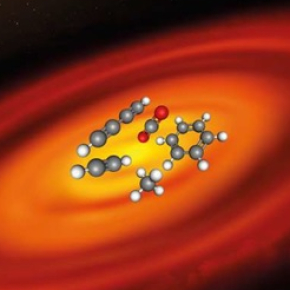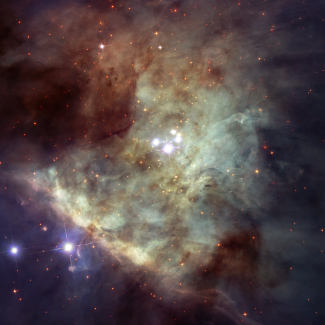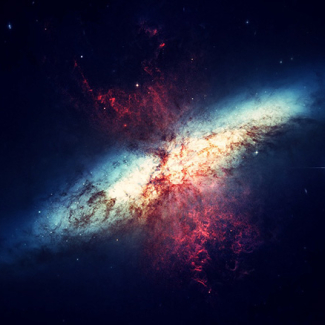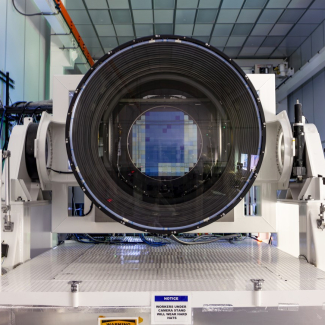
James Webb Space Telescope reveals composition of protoplanetary disc
|
|
An international research team including scientists from the CNRS, Université Paris-Saclay and the French Alternative Energies and Atomic Energy Commission CEA, supported by the French Space Agency CNES, has revealed the chemical composition of a disc of matter rotating around a young star, from which new planets are forming. Surprisingly, this is rich in hydrocarbons, two of which have even been detected in a protoplanetary disc for the first time ever. The findings, published on May 11 in the journal Nature Astronomy, were obtained using the MIRI instrument developed by a consortium of laboratories in Europe1 and the United States.
- 1With the CEA as lead funding agency and CNES as prime contractor, several French laboratories played a key role in delivering the MIRI imager: the Laboratoire Astrophysique, Instrumentation, Modélisation (CEA/CNRS/Université Paris Cité), the Institut d'Astrophysique Spatiale (CNRS/Université Paris-Saclay), the Laboratoire d'Études Spatiales et d'Instrumentation en Astrophysique (Observatoire de Paris-PSL/CNRS/Sorbonne Université/Université Paris Cité), and the Laboratoire d'Astrophysique de Marseille (CNRS/Aix Marseille Université).
Planets are born from the discs of dust and gas that form around a young star after its birth. Matter clumps together there, forming 'protoplanets' that continue to grow by accreting the material they encounter in the disc. However, this process remains poorly understood.
Now, scientists from 11 European countries1 working together within the MINDS consortium (MIRI mid-Infrared Disk Survey) have partially lifted the veil on one of the mysteries that still surround protoplanetary discs, namely their chemical composition. Observations of the very young star J1605322 and its disc, carried out using the James Webb Space Telescope, have revealed a surprising abundance of hydrocarbons, some of which have even been detected for the first time ever in a disc.
To do this, the research team used the telescope's MIRI spectrometer. By analysing the infrared light emitted by the gas in the disc of J160532, the instrument detected a very large quantity of acetylene (C2H2), a simple and highly reactive hydrocarbon molecule. In addition, the identification of two other hydrocarbons never before seen in protoplanetary discs, benzene (C6H6) and diacetylene (C4H2), also came as a surprise.
The J160532 disc thus appears extremely rich in carbonaceous molecules in gaseous form, but very poor in water and carbon dioxide, even though these two oxygen-containing molecules are frequently detected in other discs. The authors of the paper suggest that the solid carbon in the J160532 disc may have entered the gaseous state due to the intense activity of the young star. This would imply that rocky planets formed from the dust grains in the disc would be likely to have a carbon-poor mineral composition, just like Earth, whereas gas planets should be carbon-rich.
The consortium chose to focus on J160532 because of its low mass, around a fifth to a tenth that of the Sun. In recent years, observations have shown that rocky exoplanets are very abundant around such low-mass stars. Such exoplanets also often form in the habitable zone of their star, as shown by the well-known Trappist-1 exoplanet system.
The findings provide a first indication of the potential of the James Webb Space Telescope to uncover the physical and chemical conditions that exist during planetary formation. Scientists now hope to study the full diversity of protoplanetary discs, with the aim of understanding how the same physical processes that occur in all discs lead to the different types of planets observed throughout the Universe, including those in our own Solar System.
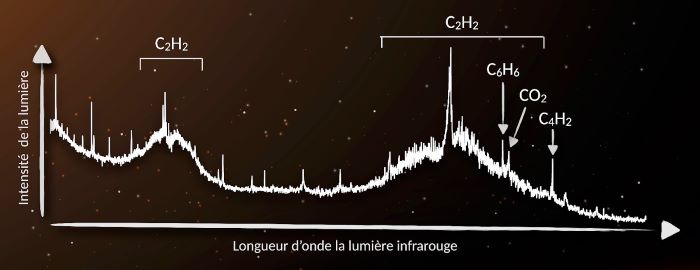
© Benoît Tabone/MINDS consortium/NASA/ESA
- 1In France, the research involved scientists from the Institut d’Astrophysique Spatiale (CNRS/Université Paris-Saclay), the Laboratoire Astrophysique, Instrumentation, Modélisation (CNRS/CEA/Université Paris Cité,) the Laboratoire d’Etudes du Rayonnement et de la Matière en Astrophysique et Atmosphères (Observatoire de Paris – PSL/CNRS/Sorbonne Université/Université de Cergy-Pontoise), and the Laboratoire de Météorologie Dynamique (CNRS/ENS-PSL/École polytechnique/Sorbonne Université), as well as funding by the French Space Agency CNES.
- 2J160532 formed around three million years ago, as compared to over four billion years ago for the Sun.
A rich hydrocarbon chemistry and high C to O ratio in the inner disk around a very low-mass star. Tabone et al. Nature Astronomy, 11 May 2023. DOI:10.1038/s41550-023-01965-3
